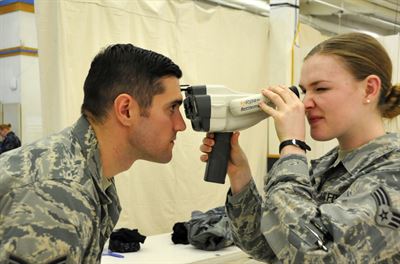

The Defense Department is putting an emphasis on jointness and addressing injuries in the field in order to ensure military competitiveness.
Best listening experience is on Chrome, Firefox or Safari. Subscribe to Federal Drive’s daily audio interviews on Apple Podcasts or PodcastOne.
The military is in the midst of turning over its medical treatment facilities to the Defense Health Agency in hopes of finding efficiencies.
But, the Defense Department hopes the consolidation will do more than just save money, it also wants the transformation to better prepare the military health system for competition with countries like China and Russia.
“Our concept of warfare has to evolve back to what it used to be,” said Rear Adm. Colin Chinn, the Joint Staff Surgeon, during a speech Thursday at the Association of Military Surgeons of the United States annual conference in National Harbor, Md. “We spent the last 15 or 20 years in counterinsurgency operations, well now we are back in the world of great power competition in which conventional warfare may be what we have to plan for.”
Chinn said the challenge for the military medical community is now providing care in areas where the United States may not have dominance in the air, land or sea.
DoD hopes DHA’s administration over the military services’ medical communities will provide interoperability and uniformity between the services and allies, so medical treatment can be more efficient in those contested environments, Chinn said.
That’s why DHA will not only have ownership of the medical treatment facilities, but it is also in charge of supporting medical health services as it standardizes IT, infrastructure and medical processes. It also measures readiness, tracks effectiveness and standardizes products between the services.
Chinn and the military services’ surgeons general said the transition to DHA and to conventional warfare puts an emphasis on jointness between the services in the medical field.
What that means for the Joint Staff is, first of all, providing a picture of the readiness of the overall force or what Chinn calls the “joint medical estimate.”
“Right now, if you asked me, ‘Doc, what is the medical readiness of the joint force?’ Right now, I cannot answer that for a variety of reasons,” Chinn said. “We are now working with our partners to create a joint estimate so I can answer that question.”
It also means bringing together joint leaders to assess the medical situation. Next week will be the first meeting of the medical “Ops Deps” — a gathering of senior leaders — which brings together nine combatant command surgeons general with the surgeons general of the military services, and the head of DHA.
Chinn said the group elevates medical issues to more senior leaders so medical needs can get the support they need, and be put into budget planning for funding.
Lt. Gen. Dorothy Hogg, the Air Force surgeon general, stressed the need for cooperation among the services as well.
“We’ve got to do better at being joint,” she said. “We’ve got to find where those synergies are and how we become more interoperable because our medics do that downrange without even thinking about it. How can we do that better stateside? Train them better together, look at equipment, we need to be more standardized so when they go downrange they are not trying to figure out different equipment just because it comes from a different service. Also, education. Where can we capitalize on the education of being joint?”
While the leadership is trying to work better together, the services realize they need to change the way medics work in the field.
“As our competitors in the world have changed we’ve realized two things,” Sgt. Maj. Michael Gragg, of the Army medical service corps command, told Federal News Network. “One, we realize that we have a gap in our ability to provide prolonged field care in a sustained environment at a location because we’ve been fighting an enemy where we’ve had air superiority. We might not have that in the future.”
Gragg said the military needs to provide care at the point of injury until the individual can be transferred to better care.
Secondly, Gragg said the weapons used in conventional warfare will require all soldiers to have more advanced medical training.
“We are establishing our Tactical Combat Casualty Care to make sure everyone has the ability to do minimal lifesaving standards, because truly the life is saved by the first responder,” Gragg said.
The Navy is also changing the way it works in the field.
“We find that the way we historically task organized at sea with hospital ships may not be sufficient,” said Navy Surgeon General Vice Adm. Forrest Faison III. “We will look at deploying not only the hospital ships to provide that roll through capability that is mobile and adaptable, but also smaller teams on individual platforms.”
Faison said the smaller teams may be embedded with units or work on land, and it means every sailor must be trained, ready and qualified to save lives.
Copyright © 2024 Federal News Network. All rights reserved. This website is not intended for users located within the European Economic Area.
Scott Maucione is a defense reporter for Federal News Network and reports on human capital, workforce and the Defense Department at-large.
Follow @smaucioneWFED

